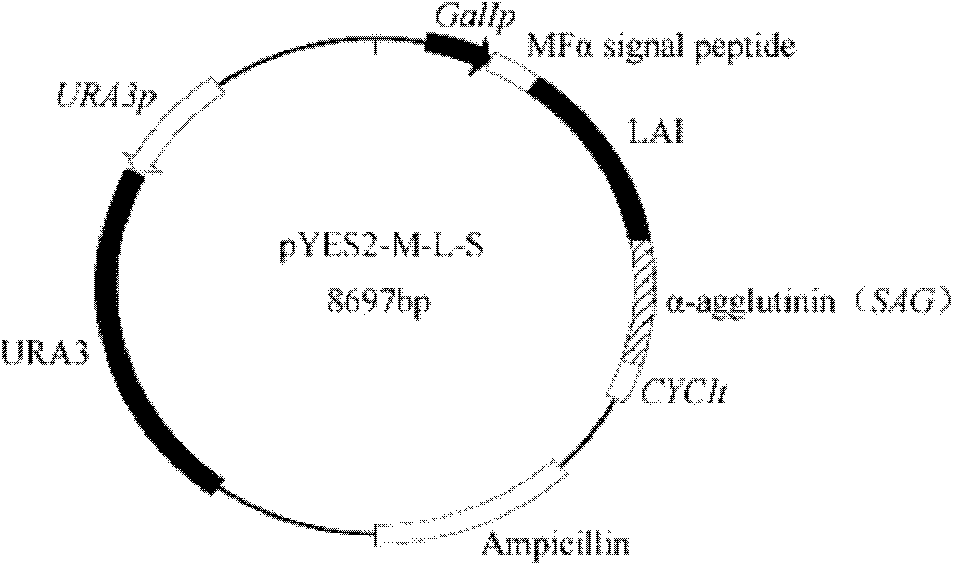Method for catalytically synthesizing conjugated linoleic acid by saccharomyces cerevisiae display linoleic acid isomerase
A technology of linoleic acid isomerase and conjugated linoleic acid, which is applied in the field of bioengineering, can solve the problems of expression product retention, low expression efficiency, and inability to achieve secreted expression, so as to reduce production costs and improve transformation efficiency Effect
- Summary
- Abstract
- Description
- Claims
- Application Information
AI Technical Summary
Problems solved by technology
Method used
Image
Examples
Embodiment 1
[0020] Example 1 Construction of Yeast Display Recombinant Plasmid
[0021] Lactobacillus plantarum (Lactobacillus plantarum) lp15-2-1 and Saccharomyces cerevisiae K601 genomic DNA were respectively used as templates, and the primers in Table 1 were used for PCR amplification. The PCR reaction system was: 10×PCR buffer (containing Mg 2+ ) 5 μL, dNTPs (25mM) 4 μL, primer 1 and primer 2 (10 μM) 1 μL each, genomic DNA 1 μg, ExTaq DNA polymerase 1U, add sterile ultrapure water to a final volume of 50 μL; PCR reaction conditions: 94 ° C pre-denaturation for 5 min Denaturation at 94°C for 30s, annealing at 48°C for 30s (gene mfα1) / annealing at 50°C for 40s (linoleic acid isomerase gene lai and yeast α-lectin C-terminal anchor region gene sag containing 321aa), extension at 72°C for 1min , reacted for 30 cycles; extended at 72°C for 5 min. The signal peptide gene mfα1 (SEQ ID NO: 3), the linoleic acid isomerase gene lai (SEQ ID NO: 1) and the anchor region gene sag (SEQ ID NO: 2). ...
Embodiment 2
[0025] Example 2 Obtaining and Screening of Recombinant Yeast
[0026] SD (uracil-deficient) solid screening medium (g / L): SD+2% agar powder
[0027] SD medium composition (g / L): 16.8g yeast nitrogen source; 0.77g uracil-deleted amino acid; 2g galactose.
[0028] There is URA gene on the vector pYES2, and the recombinant yeast can grow on the medium lacking uracil, so the SD solid screening medium is selected to screen the transformants.
[0029] The above-mentioned recombinant plasmid was transformed into Saccharomyces cerevisiae K601 by electric shock method, and the electric shock cup was transferred to the electric shock seat with Bio-Rad's gene electric shock transformation instrument (BTX), and the electric shock transformation was carried out. The conditions were: the voltage was 1.5KV; 25μF; resistance 200Ω; electric shock time 5s; then cultured upside down on SD solid screening medium, 30°C, cultured for 48 hours, and screened to obtain transformants; finally, the ob...
Embodiment 3
[0030] Example 3 Determination of Recombinant Yeast Enzyme Activity and Transformation Product Analysis
[0031] YPG induction medium composition (g / L): 10g peptone; 5g yeast extract; 10g galactose.
[0032] The recombinant yeast obtained above was inoculated into YPG induction medium, and after cultivating at 30°C for 48h, centrifuged (3000r / min, 10min,) to collect the bacterial cells, the collected bacterial cells were washed with physiological saline (0.9% v / v ) after washing twice, add to the phosphate buffer solution (0.1mol / l, pH7.0) containing 3mg / ml linoleic acid; 30 ℃, under the condition of 180rpm, carry out conversion reaction, measure linoleic acid by sampling every 6 hours The enzymatic activity of isomerase was compared with the transformation product of yeast cells carrying the empty vector pYES2, and the results were as follows: image 3 As shown, it can be seen from the figure that with the increase of culture time, the enzyme activity of the recombinant yeas...
PUM
| Property | Measurement | Unit |
|---|---|---|
| concentration | aaaaa | aaaaa |
| capacitance | aaaaa | aaaaa |
| electrical resistance | aaaaa | aaaaa |
Abstract
Description
Claims
Application Information
 Login to View More
Login to View More - R&D
- Intellectual Property
- Life Sciences
- Materials
- Tech Scout
- Unparalleled Data Quality
- Higher Quality Content
- 60% Fewer Hallucinations
Browse by: Latest US Patents, China's latest patents, Technical Efficacy Thesaurus, Application Domain, Technology Topic, Popular Technical Reports.
© 2025 PatSnap. All rights reserved.Legal|Privacy policy|Modern Slavery Act Transparency Statement|Sitemap|About US| Contact US: help@patsnap.com



